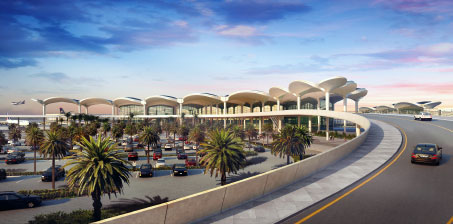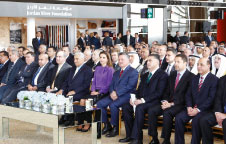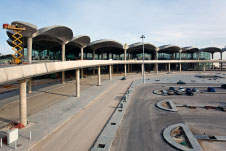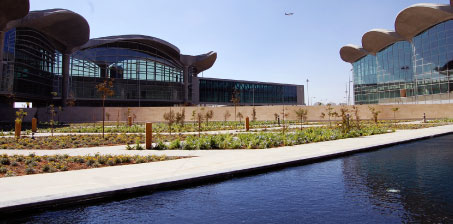
Central to the redevelopment of Queen Alia International Airport is the state-of-the-art new terminal, which provides a capacity of seven million passengers per year in its first phase.
Airport International Group (AIG) is managing and redeveloping Jordan’s premier gateway under a 25-year Build-Operate-Transfer (BOT) concession, which was awarded in 2007. Central to the redevelopment of Queen Alia International Airport (QAIA) is the landmark US$750 million (€575m) terminal that opened on 21 March, with the overnight transfer of operations from the old facility. In addition, AIG invested US$100 million (€75m) in the airport’s existing facilities prior to the opening of the new terminal. Under the terms of the BOT concession, the government retains ownership of the airport and receives a proportion of gross revenues for the duration of the agreement (54.47% for the first six years and 54.64% thereafter).
The Jordanian government’s aim is to double tourism revenue to JOD4.2 billion (€4.5bn) by 2015, and AIG’s role in managing the airport efficiently, opening the new state-of-the-art terminal and investing in strong marketing efforts to attract airlines, are major factors contributing to the government’s drive.
“QAIA has the benefit of being in one of the fastest-growing regions in the world,” commented Kjeld Binger, CEO, AIG. Indeed, the airport achieved +14% growth to six million passengers in 2012. Throughput has exceeded the airport’s original capacity of 3.5 million annual passengers for the last four years, and the new terminal eliminates those capacity constraints, providing an initial capacity of seven million passengers per year. When the existing terminal is demolished and the piers expanded, capacity will increase to nine million, with later pier expansions to result in an ultimate annual capacity of 12 million passengers.

His Majesty King Abdulla II inaugurated the new QAIA terminal on 14 March in the presence of Her Majesty Queen Rania Al Abdullah.
Growth has continued into 2013; the latest available figures show a +2.6% increase in January to 475,000 passengers. “QAIA’s continued traffic growth is a positive indicator of the airport’s expected performance in 2013, and underscores the necessity of the new state-of-the-art terminal in accommodating the projected increase in passenger and flight numbers,” explained Binger. “QAIA is poised to become a niche transit hub in the region, adding great value to Jordan’s economic development.”
Transfer traffic currently accounts for around 20% of QAIA’s total traffic and Binger added that he sees a growth trend in this area, particularly in light of national carrier Royal Jordanian having 11 787s on order, which are key to the airline’s plans to broaden its long-haul network. The first of these 787s will be delivered in 2014.
New routes, and increased frequencies, launched from QAIA in 2012 included Royal Jordanian to Abu Dhabi, Misrata and Al Ain; Royal Falcon to Abu Dhabi, Cairo, Jeddah, Najaf and Mosul; Cyprus Airways to Larnaca and Afriqiyah Airways to Tripoli/Benghazi.
A new route incentive scheme was introduced in January 2011, with airlines serving eligible routes benefiting from reduced aeronautical charges. The discount is 30% in Year 1, 20% in Year 2 and 10% in Year 3. Services must be operated to/from a new city/airport pair; they must also operate a minimum of three flights per week.
“We have a very focused approach to route development,” explained Binger. “We should be looking more at the Asian market, including China – we see good potential there. There are also ongoing talks with low-cost carriers in Europe; there is room for developing these services.”
Sense of place

Transfer traffic currently accounts for around 20% of QAIA’s total traffic and Binger sees this growing: “QAIA is poised to become a niche transit hub in the region, adding great value to Jordan’s economic development.”
The iconic design of the new 103,000sqm terminal was created by Sir Norman Foster – the stand out characteristic being the roof design, which was inspired by Bedouin tents. It is composed of 127 concrete domes, each weighing up to 600 tonnes. The concrete used for the roof domes weighs over 55,000 tonnes. The design is intended to resonate with a sense of place and local culture. Binger explained that Jordan experiences dramatic changes in temperature, with summer temperatures varying markedly between day and night time; consequently, the high thermal mass of the material used provides passive environmental control. The terminal is glazed on all sides, providing views of aircraft on the apron and aiding passenger orientation. Two piers of departure gates run along either side of the central building, which contains the main processing areas, shops, restaurants and lounges.
The new terminal increases retail space by 25% to more than 6,000sqm, with the number of outlets rising from 29 to 39. Most recently, AIG signed partnership agreements with two non-profit, non-governmental organisations – Jordan River Foundation (JRF) and the Royal Society for the Conservation of Nature (RSCN) – which develop socio-economic and environmental initiatives designed to empower local communities by generating employment opportunities. They will showcase and sell traditional handmade products in the new terminal. Binger said: “These organisations have been instrumental in employing underprivileged Jordanians in marginalised and rural areas. Through this partnership, not only do we hope to support them in securing sustainable incomes for their beneficiaries, but we also aim to give them the opportunity to showcase Jordan’s rich culture and local craftsmanship to our esteemed passengers.”

The iconic design of the new 103,000sqm terminal was created by Sir Norman Foster – the stand out characteristic being the roof design, which was inspired by Bedouin tents.
The redevelopment heralds what Binger describes as a new era for QAIA, as it strives to achieve its vision of becoming the airport of choice in the region with strong global connections. The new terminal provides the capacity to pursue that vision and to handle the continued strong growth that is forecast.







